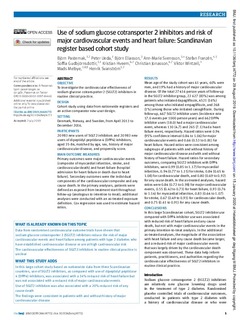| dc.description.abstract | Objective To investigate the cardiovascular effectiveness of sodium glucose cotransporter 2 (SGLT2) inhibitors in routine clinical practice.
Design Cohort study using data from nationwide registers and an active-comparator new-user design.
Setting Denmark, Norway, and Sweden, from April 2013 to December 2016.
Participants 20 983 new users of SGLT2 inhibitors and 20 983 new users of dipeptidyl peptidase 4 (DPP4) inhibitors, aged 35-84, matched by age, sex, history of major cardiovascular disease, and propensity score.
Main outcome measures Primary outcomes were major cardiovascular events (composite of myocardial infarction, stroke, and cardiovascular death) and heart failure (hospital admission for heart failure or death due to heart failure). Secondary outcomes were the individual components of the cardiovascular composite and any cause death. In the primary analyses, patients were defined as exposed from treatment start throughout follow-up (analogous to intention to treat); additional analyses were conducted with an as-treated exposure definition. Cox regression was used to estimate hazard ratios.
Results Mean age of the study cohort was 61 years, 60% were men, and 19% had a history of major cardiovascular disease. Of the total 27 416 person years of follow-up in the SGLT2 inhibitor group, 22 627 (83%) was among patients who initiated dapagliflozin, 4521 (16%) among those who initiated empagliflozin, and 268 (1%) among those who initiated canagliflozin. During follow-up, 467 SGLT2 inhibitor users (incidence rate 17.0 events per 1000 person years) and 662 DPP4 inhibitor users (18.0) had a major cardiovascular event, whereas 130 (4.7) and 265 (7.1) had a heart failure event, respectively. Hazard ratios were 0.94 (95% confidence interval 0.84 to 1.06) for major cardiovascular events and 0.66 (0.53 to 0.81) for heart failure. Hazard ratios were consistent among subgroups of patients with and without history of major cardiovascular disease and with and without history of heart failure. Hazard ratios for secondary outcomes, comparing SGLT2 inhibitors with DPP4 inhibitors, were 0.99 (0.85 to 1.17) for myocardial infarction, 0.94 (0.77 to 1.15) for stroke, 0.84 (0.65 to 1.08) for cardiovascular death, and 0.80 (0.69 to 0.92) for any cause death. In the as-treated analyses, hazard ratios were 0.84 (0.72 to 0.98) for major cardiovascular events, 0.55 (0.42 to 0.73) for heart failure, 0.93 (0.76 to 1.14) for myocardial infarction, 0.83 (0.64 to 1.07) for stroke, 0.67 (0.49 to 0.93) for cardiovascular death, and 0.75 (0.61 to 0.91) for any cause death.
Conclusions In this large Scandinavian cohort, SGLT2 inhibitor use compared with DPP4 inhibitor use was associated with reduced risk of heart failure and any cause death, but not with major cardiovascular events in the primary intention-to-treat analysis. In the additional as-treated analyses, the magnitude of the association with heart failure and any cause death became larger, and a reduced risk of major cardiovascular events that was largely driven by the cardiovascular death component was observed. These data help inform patients, practitioners, and authorities regarding the cardiovascular effectiveness of SGLT2 inhibitors in routine clinical practice. | nb_NO |

